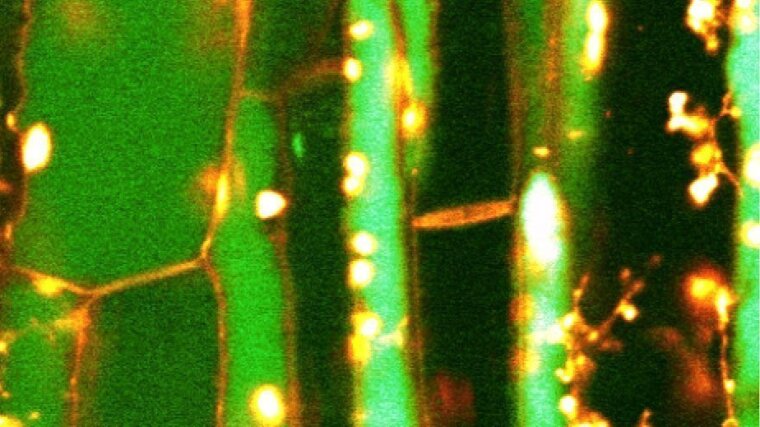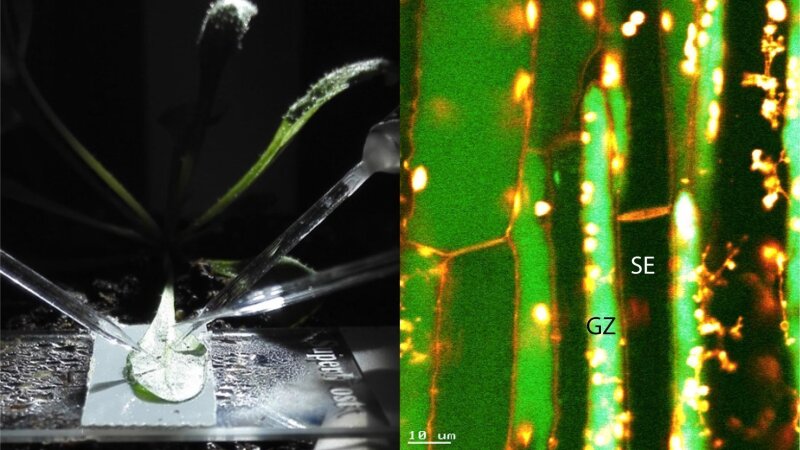
- Life
- Research
Published: | By: Esther Schwarz-Weig
PD Dr Alexandra Furch from the University of Jena.
Image: F. ZimmermannWhen plants are attacked by pathogenic bacteria, they use chemical and electrical signals to transmit the information from the point of origin on the leaf surface to the inside and go into defence mode. In order to find out how and where the perception of bacterial contact is converted into electrical signals, a research team led by PD Dr Alexandra Furch from the University of Jena investigated how the external stimulus is transmitted. The researchers discovered two different types of electrical waves that trigger both the local and the systemic defence reaction of plants. The team reports this in a recently published study in the journal Science Advances. Another new finding is that so-called barrier proteins in the pathways play a role in the defence response of the plant species studied. These findings could be used to equip plants with greater resistance of their own and thus reduce the use of pesticides.
For their investigations, the researchers stimulated leaves of thale cress (Arabidopsis thaliana) and broad bean (Vicia faba) with a bacterial molecule that triggers the immune response in plants. The plant cells then released calcium ions, which in turn set off a chain reaction. The external stimulus was transmitted from the epidermal cells to the inside of the leaf in the form of different electrical potentials. For the first time, the team was able to identify two different potentials in both plants: fast and far-reaching action potentials and slow and localized variation potentials, both of which propagated in waves and triggered different reactions.
Two types of potential
After the epidermal cells are stimulated, the slow variation potentials spread first. They cause so-called barrier proteins to temporarily close the pathways in the plant leaves. "Until now, it was only known that these barrier proteins block the pathways after injury and stress, such as heat or cold," says Alexandra Furch. In its study, the team has now shown for the first time "that this reaction also occurs in response to a biological stimulus, after contact with harmful bacteria," continues the expert, who has been intensively researching such barrier proteins for a long time. "Until now, it was assumed that these barrier proteins were solely responsible for regulating the distribution of nutrients in the sieve tubes of the plant pathways."
In addition, the fast action potentials travelling along the pathways activated the plants' systemic immune defence: they lead to increased production of the plant hormone jasmonate, which coordinates the immune response of plants, and to the release of reactive oxygen compounds, which are also involved in the plant's immune response against pathogens.
Interplay of chemical and electrical signals
In their study, the researchers also developed a model for how the complex interplay of various chemical and electrical signals in the plant is orchestrated in order to spread the external stimulus of bacterial attack throughout the organism and trigger both the local and the systemic immune response: The signals are first slowly transmitted from the outer epidermal cells to the cells further inside and then quickly – within minutes – spread further along the pathways in the plant, where they activate other parts of the immune system. "This mixture of different signals contains a kind of code that is deciphered in the target tissue and triggers a targeted specific response to the relevant attackers," says Alexandra Furch. Exactly how this works, however, still needs to be analysed.
The team was able to detect both types of potential in the plant species studied. As these belong to two different plant families and are only distantly related, it could be a universal pattern of the plant immune response. Applying the analysis methods to two such different plant species was challenging, says Alexandra Furch. In the end, it was also possible thanks to the collaboration with researchers led by Gundula Noll from the University of Münster and other colleagues from Halle, Jena, Tübingen and Giessen.
Starting point for resistant crops
This universal mechanism of the plant immune response offers a starting point for improving the resistance of crops to pathogens in the future. This is becoming increasingly important as new pathogens emerge and spread in the wake of the climate crisis, emphasizes Alexandra Furch. "If we succeed in equipping plants with improved natural resistance, the use of chemical pesticides can also be reduced."
Electrical signals in the Arabidopsis plant leaf can be measured under microscopic control using microelectrodes made of finely drawn glass (left). In the conduction pathways of the broad bean, electrical signals rush along the dark green sieve elements (SE) in the light green guard cells (GZ; right), which are closely linked to them. In the image on the right, the photosynthesis-driving chloroplasts light up brightly under the microscope.
Image: Tom Haufschild (l.), Alexandra Furch (r.)Original publication: Furch A. C. U. et al. (2025): Transformation of flg22 perception into electrical signals decoded in vasculature leads to sieve tube blockage and pathogen resistance. Science Advances Vol 11, Issue 9; DOI: https: https://www.science.org/doi/10.1126/sciadv.ads6417External link

